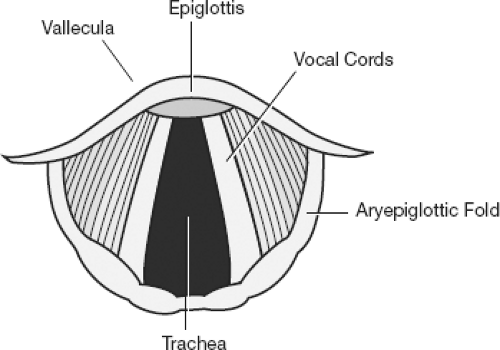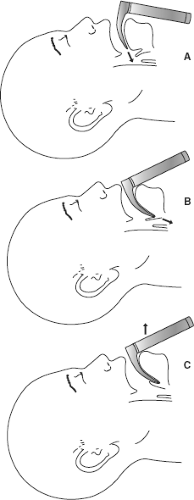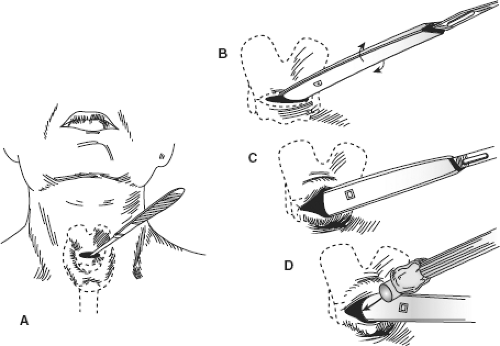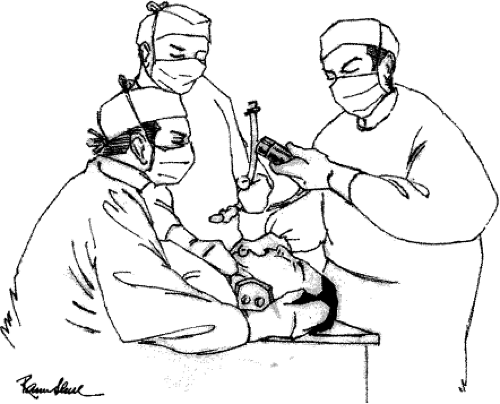Airway Management and Anesthesia
Henry E. Wang
Jean-Francois Pittet
Donald M. Yealy
I. General Considerations
Ensuring adequate oxygenation, ventilation, and protection from aspiration are the first priorities when treating an injured patient. Trauma patients have physiologic and anatomic challenges that magnify the complexity of airway management. For patients requiring acute surgical intervention, these challenges may complicate the provision of anesthesia. This chapter provides an overview of the basic principles of adult trauma airway management and anesthesia.
Airway management consists of both basic (e.g., bag-valve-mask [BVM] ventilation) and advanced (e.g., endotracheal intubation [ETI]) airway interventions. Basic airway interventions are more important than advanced interventions.
Airway management must follow a clear, deliberate, systematic plan, including the anticipation of failure and having alternative/rescue interventions.
Assume all trauma patients have a cervical spine injury, head injury, and hypovolemia. All airway management interventions must be performed with cervical immobilization and avoid hypoxemia (which can worsen any neurologic injury).
Most trauma patients require the use of pharmacologic agents to facilitate ETI. Only properly trained and experienced personnel should use deep sedatives and neuromuscular blocking agents (NMB; paralytics) to facilitate ETI.
Airway procedures should be performed by the most experienced person available and without distraction. No other procedures should occur during intubation or other airway management efforts.
Airway management of the trauma patient is a team effort. Communication between the airway manager and the trauma team leader is essential. The ultimate decision to perform ETI or other advanced airway procedures should rest with the trauma team leader.
Resuscitation of the major trauma patient begins in the field and Emergency Department (ED), continues during surgery, and is ongoing in the intensive care unit. Anesthesia and surgical intervention may exacerbate fluid and blood losses. Trauma teams must work together and bridge resuscitative efforts across these three areas.
II. Anatomy
The key structures that are visualized during ETI include the epiglottis, vallecula, vocal cords, and aryepiglottic folds (Fig. 3-1). A cross-sectional view of airway structures during orotracheal intubation is depicted in Figure 3-2. Anatomical landmarks for cricothyroidotomy are depicted in Figure 3-3.
III. Basic Airway Interventions
All patients should receive basic airway interventions. All interventions must be performed with inline cervical immobilization. Two or three operators may be needed to maintain basic airway control.
In alert and spontaneously breathing patients, apply a non-rebreather mask with 100% oxygen (10 to 15 L/min).
In semi-conscious or obtunded patients:
If possible, insert an oropharyngeal or nasopharyngeal airway. (Use extreme caution when inserting a nasopharyngeal airway in a patient with a suspected midface or basilar skull fracture.)
Use the jaw-thrust maneuver to open the airway. Do not use head tilt/chin lift on trauma patients because of the risk of cervical spine injury.
If the patient is spontaneously breathing, use a non-rebreather mask with 100% oxygen.
If the patient is not breathing spontaneously, if respiratory effort is inadequate, or if oxygen saturation cannot be maintained >95%, use BVM ventilation.
BVM of the trauma patient requires at least two operators: One to perform a jaw thrust and seal the mask, and one to squeeze the bag.
Use large-bore suction to keep the airway clear of blood and secretions.
IV. Advanced airway interventions-ETI (orotracheal).
If basic airway interventions fail or will not sustain adequate oxygenation and ventilation, advanced airway management may be considered. ETI is the most common method of advanced airway management. ETI may protect the airway from aspiration and facilitate controlled ventilation. Orotracheal intubation is the most common and the preferred method of ETI in trauma patients. Alternate/rescue and surgical airway techniques are described in Sections VII and VIII.
General considerations
ETI of the trauma patient is best approached as a “difficult airway” at all times, and ETI should be attempted by the most qualified operator available. There is high potential for ETI failure in trauma patients and alternative strategies must be planned.
Perform ETI with manual inline cervical immobilization, cervical collar removed. Flexion and extension of the head should never be used to facilitate ETI in trauma patients. Likewise, the sniffing position is contraindicated in trauma patients.
ETI requires the coordination of multiple tasks. It is best done with three rescuers.
Most trauma patients will require pharmacologic agents (deep sedation or rapid-sequence intubation [RSI]) to facilitate ETI (Section VI).
In the event of serious facial injury distorting oral or airway structures, it may be necessary to proceed directly to another advanced intervention (e.g., a supraglottic or surgical airway).
Indications for ETI. These are general indications and do not encompass all possible clinical scenarios.
Apnea or near apnea
Airway obstruction or respiratory compromise unrelieved with basic interventions
Depressed consciousness from head trauma or any other cause
Combativeness unresolved with oxygen
Respiratory distress (severe tachypnea, increased work of breathing, cyanosis, hypoxemia, etc.)
Facial or neck injury with potential airway compromise
Chest wall injury or dysfunction with respiratory compromise
Persistent or refractory hypotension
Need for diagnostic or therapeutic procedures in patients at risk for deterioration (e.g., computed tomography in somnolent patient, etc.)
Technique for orotracheal intubation
Prepare and test all intubation equipment prior to patient arrival.
For a typical 50 to 80 kg adult, use a curved (Macintosh no. 3 or 4) or straight (Miller no. 3) blade. Test the light.
Use a no. 7.0 to 7.5 endotracheal tube on average-sized adult females and a no. 7.5 to 8.0 tube on males. Children under 8 years require smaller uncuffed tubes (Chapter 46). Insert a stylet, then test the cuff.
Prepare and test large-bore suction.
Prepare pharmacologic agents (Section VI).
Prepare an alternate/rescue airway plan (Sections VII and VIII).
Oral intubation requires at least three rescuers (Fig. 3-4).
Rescuer 1: The most experienced provider; performs laryngoscopy and placement of endotracheal tube.
Rescuer 2: Performs manual cervical immobilization and applies cricoid pressure.
Rescuer 3: Provides oxygenation, assists rescuer 1 with laryngoscopy (handing equipment to intubator, etc.), facilitates verification of tube placement, and performs postintubation ventilation.
Most patients will be supine–-if not, lay the patient flat and adjust the bed height to ease laryngoscopy. Rescuer 2 maintains manual cervical immobilization. We recommend that rescuer 2 stand to the patient’s side, facing the intubator—this gives the intubator more room while making it easier to use both hands to support the neck and jaw.
Rescuer 3 should oxygenate the patient using a non-rebreather mask or BVM ventilation (Section III). Use 100% O2 (10 to 15 L/min); if possible, optimize oxygenation and ventilation (spontaneous breathing or assisted) for 3 to 4 minutes; this technique maximizes pulmonary oxygen reserves. If possible, oxygenate to SaO2 of 100%.
Ensure a functioning intravenous catheter for drug administration.
When directed, rescuer 2 unfastens the cervical collar while maintaining cervical stabilization. Apply firm cricoid pressure only when requested by the intubator—the maneuver does not universally aid or prevent harm.
Give sedative and/or paralytic drugs (Section V).
Perform laryngoscopy (insert the laryngoscope blade and expose the vocal cords) (Fig. 3-2).
With a curved (Macintosh) blade, insert the blade in the right side of the patient’s mouth and sweep the tongue to the left. Insert the tip of the blade in the vallecula (the space between the tongue and the epiglottis)—pressure placed on the hyoepiglottic ligament will lift the epiglottis and expose the vocal cords. With a straight (Miller) blade, similarly insert the blade in the right side of the patient’s mouth, but directly lift the epiglottis with the tip of the blade.
Maintain inline stabilization of the cervical spine. Head tilt/extension, neck flexion, and “sniffing position” should never be used in trauma patients. Cricoid pressure may improve laryngoscopic view but again is done at request only.
Limit the duration of each laryngoscopy attempt to 30 seconds. Stop earlier if SaO2 drops ≤90%. (Caution: Oxygen desaturation may be precipitous in trauma patients.)
No other procedures should be performed while the laryngoscopy is being attempted.
Insert the endotracheal tube.
Place the tip of the tube just past the vocal cords. In a typical 70 kg patient, the tube should be placed to a depth of 21 to 22 cm for adult women and 22 to 23 cm for adult men (denoted by depth markers on the tube) measured at the patient’s teeth.
If encountering difficulty passing the endotracheal tube through the vocal cord opening, consider using a gum elastic bougie. This is a semi-rigid stylet and can be more easily inserted when glottic view is limited. The endotracheal tube can then be passed over the bougie and through the vocal cords.
Hold the tube manually—do not release the tube until placement is confirmed and the assistant is prepared to secure the tube. Similarly, do not release cricoid pressure until proper tube position is confirmed.
Inflate the cuff with 10 mL of air, remove the stylet, and attach the bag-valve device.
If tube placement fails, stop and reventilate with BVM. Then, re-attempt ETI with improved positioning. If unsuccessful after a total of three ETI attempts or if hypoxemia occurs despite BVM use, go directly to alternate/rescue airway techniques. Proceed to an alternate/rescue airway sooner if clear intubating barriers are encountered during initial ETI attempts.
Confirm correct tube placement. Unrecognized tube misplacement (esophageal or hypopharyngeal) can be rapidly fatal. No singular method of monitoring or tube confirmation is infallible. Use a combination of focused examination and adjunct devices to confirm tube placement.
Full access? Get Clinical Tree










